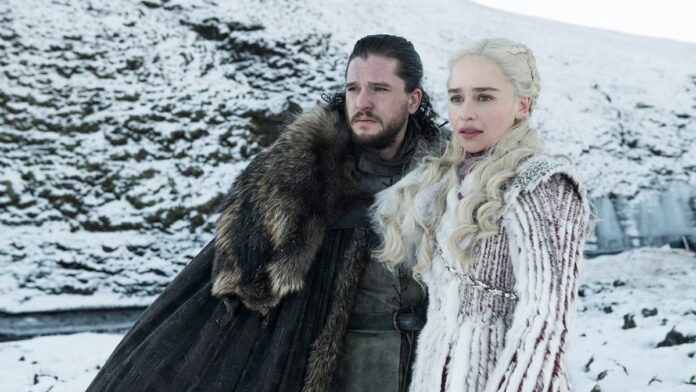Game of Thrones’ place in history is assured. A decade after Peter Jackson’s Oscar-winning The Lord of the Rings trilogy, HBO’s epic, brutal adaptation of George RR Martin’s A Song of Ice and Fire series of novels rewrote the rules for fantasy storytelling – this being the home of The Sopranos and True Blood, taking a trip to Westeros was never going to be as homely as JRR Tolkien’s Middle-earth.
Game of Thrones’ unprecedented success paved the way for The Witcher, The Wheel of Time and even Amazon’s own take on The Lord of the Rings, The Rings Of Power, but there were ups and downs along the way. So, with prequel series House of the Dragon imminent, we take a look back through eight years of feuding families, extreme violence and political scheming in the Seven Kingdoms, to rank Game of Thrones’ seasons from worst to best.
And be careful – Westeros is a dangerous place with MANY SPOILERS AHEAD.
8. Season 8 (2019)
Wrapping up one of the biggest TV shows of all time was always going to be a mission of epic proportions. And while the final six episodes of the saga are not the disaster many naysayers would claim, there’s no question that they struggle to deliver on eight years of ever-expanding hype.
Aside from a surprisingly talky opening episode, the entire season is a breakneck sprint to the finish, seemingly more concerned about delivering headline-grabbing moments than satisfying character arcs. Some of those moments are up there with the show’s best – Arya slaying the Night King, Brienne belatedly getting a knighthood, Clegane vs Clegane – but there’s just as many questionable decisions in the showrunning department. The fight for Winterfell in ‘The Long Night’, for example, could have been the show’s signature battle, but the unrelenting darkness was enough to test the contrast settings on all but the very best TVs.
The season’s biggest misstep, however, is its treatment of Daenerys, turning her from sympathetic ruler to a genocidal, dragon-riding maniac in what feels like an instant. By the time the ultimate fate of the Iron Throne is decided – the whole point of the show, remember – the whiff of anti-climax lingers like dragon smoke. Season 8 isn’t bad enough to sully the brilliance of what came before, but such an iconic, groundbreaking show deserved better than this.
7. Season 7 (2017)
After numerous seasons of increasing complexity, season 7 is where the writers had the finishing line in their sights. It shines through in the storytelling.
Although it’s not as much of a dash as the finale, this penultimate year makes some bizarre sacrifices in the name of narrative convenience. Remember how characters used to spend entire seasons travelling between castles? Now we learn that Gendry can sprint vast distances in minutes if the fate of Westeros depends on it.
Nonetheless, the season has some brilliant set-pieces, including the Stark sister-engineered execution of conniver-in-chief Littlefinger, and Lady Olenna’s glorious final words after she’s been poisoned for her part in King Joffrey’s death. Dame Diana Rigg wasn’t in Game of Thrones all that much, but she lifted every single scene she was in.
And as Jon Snow does his best to rally the Seven Kingdoms to take on the threat of the White Walkers – now armed with a zombie dragon – the season also has a decent stab at out-icking the original Star Wars trilogy, when he sleeps, Daenerys. To be fair, he doesn’t yet know she’s aunt, but even Luke and Leia didn’t go that far.
6. Season 5 (2015)
Maybe showrunners David Benioff and DB Weiss were getting antsy about overtaking George RR Martin’s books – we’re still waiting for a follow-up to 2011 novel A Dance with Dragons – but this season feels like a show on standby, waiting for bigger things to happen. In fact, aside from the White Walkers’ terrifying assault on Hardhome – arguably the moment the undead Night King out-bads Cersei to become the biggest threat to Westeros – it’s relatively light on action.
That doesn’t really matter when Tyrion and Varys are forming a memorable comedy double act in Daenerys’s court, of course, but Arya’s training sequences in Braavos, and the High Sparrow’s hard-line religious revolution in King’s Landing struggle to set the pulse raising.
Perhaps the most notable thing about season 5 is that it features the show’s darkest moment – yes, that’s saying something – when Stannis Baratheon burns his daughter alive in sacrifice to the Lord of Light. It also sets Jon Snow on his religious saviour arc, as the traitorous men of the Night’s Watch murder him in cold blood. (Et tu, Ollie?) Even so, you can’t help wondering if Bran Stark did the right thing by giving this year a miss entirely.
5. Season 2 (2012)
After Ned Stark parted company with his head, this was always going to be a very different beast to its predecessor. Season 2 expands the show’s scope and ambition considerably, taking us to more and more locations on that wonderful mechanical map in the opening credits.
As Daenerys and her baby dragons set out from Essos on a journey to fulfil her destiny, five other pretenders emerge to replace King Robert Baratheon on the Iron Throne: his spiteful son Joffrey, his grumpy brother Stannis, his nicer brother Renly, “King in the North” Robb Stark, and all-round scumbag Balon Greyjoy. Not all of them make it out of the season alive…
It’s a year of familiar faces taking new paths (Stark sisters Sansa and Arya find themselves in the lion’s den with natural enemies the Lannisters, while Theon Greyjoy betrays the family who raised him), and introductions to new characters who’ll be pivotal to the future of Westeros – the noble Davos Seaforth and the ambitious Margaery Tyrell are the most notable.
It’s also the season that turned Peter Dinklage’s brilliant Tyrion into a bona fide star. The youngest Lannister sibling becomes a top-class Hand of the King before explosively saving King’s Landing from Stannis’s naval assault – it’s a shame his family never appreciated him as we did.
4. Season 3 (2013)
One shocking scene in penultimate episode ‘The Rains of Castamere’ will forever define Game of Thrones’ third season. If Ned Stark’s beheading was the moment that confirmed the veracity of that old Westerosi saying valar morghulis (all men must die), the infamous Red Wedding proved once and for all that being good is seriously bad for your health.
Stark heir Robb’s rise seems inevitable until he reneges on an agreement to marry Walder Frey’s daughter and – along with his mother, Catelyn, and pregnant wife Talisa – finds himself on the pointy end of a sword. The Lannisters send their regards, indeed.
While the wedding breakfast from hell changes the entire direction of the show – and the Seven Kingdoms – there are plenty of other things to like in season 3. With Martin’s word now well established, the show really hits its groove in terms of character development, and allows both the unlikely friendship between Brienne and Jaime, and the romance between Jon Snow and Wildling Ygritte to flourish organically. Unfortunately, it also overdoes Ramsay Bolton’s torture scenes with the unfortunate Theon Greyjoy – unfortunately, Game of Thrones never really learned when to pull back on its more gratuitous moments.
3. Season 1 (2011)
Over a decade later, it’s easy to forget how radical this debut season was. Arriving a few short months after the similarly violent The Walking Dead had brought zombies shambling into the mainstream, HBO’s punt on George RR Martin’s A Song of Ice and Fire novels showed the world that screen fantasy didn’t need Hobbits, Elves and magical rings to be successful. Indeed, part of this first year’s genius was the way it avoided alienating mainstream audiences by introducing its fantastical elements by stealth – ignore the scenes of White Walkers and dragons that bookend the season, and it could be a (very bloody) version on medieval European history.
Beyond the hallmark HBO sex and violence, however, this first season revels in reminding us that Westeros is a land where no one is safe. From incestuous Jaime Lannister pushing pre-teen Bran Stark out of a window to wannabe king Viserys’s molten gold coronation, the show set a new benchmark for watercooler conversation back in 2011. But the moment that really sealed the deal was the unexpected – unless you’d read the books, of course – execution of noble Ned Stark, played by the show’s nominal star, Sean Bean. TV would never be the same again.
2. Season 4 (2014)
Two episodes in, Game of Thrones’ fourth year gets its ‘Who Shot Mr Burns?’ moment, as the hateful Joffrey Baratheon is fatally poisoned – few are mourning his loss and everyone’s a suspect.
This bold opening sets the tone the season grows into a tour de force of fantasy storytelling, an infectious blend of set-pieces and some of the best character development on TV. It’s also the season that makes the most of Game of Thrones’ unconventional structure, where episode breaks are artificial constructs that only exist because nobody can 10 hours in one go.
Arya and the Hound assume Brienne and Jaime’s unlikely double-act mantle as they bicker their way around the Seven Kingdoms but the character who most lights up the season is newcomer Oberyn “the Sand Snake” Martell (played by future Mandalorian Pedro Pascal). This charismatic Dornishman steals pretty much every scene he’s in before his head is unceremoniously crushed by the Hound’s (very) big brother, the Mountain. Sadly, there’s no coming back from that one…
We’re also treated to the most memorable toilet seat death since Jurassic Park as Tyrion – prime suspect for Joffrey’s murder – bumps off his unsuspecting dad at his most vulnerable moment.
1. Season 6 (2016)
If Benioff and Weiss were apprehensive about overtaking Martin’s books, you wouldn’t know it from the wonderfully assured season 6. There’s a sense that the shackles are well and truly off, that – for the first time – the priority is making a brilliant TV show rather than staying faithful to the source material.
While Daenerys’ is busily rounding up allies on the other side of the Narrow Sea, Ned Stark’s descendants take centre stage: Arya starts working through her kill list in earnest, Sansa says enough is enough, and Bran learns the weird ways of the Three-Eyed Raven. Jon Snow, meanwhile, comes back from the dead, executes everyone who conspired against him, and wins the so-called “Battle of the Bastards”, despite displaying little aptitude for tactics. (If only poor, forgotten Rickon had realised that running in straight lines makes it much easier for someone to hit you with an arrow.)
The main reason season 6 tops our list, however, is the sheer quantity of Westeros-shattering moments. Whether it’s Cersei wiping out her enemies in the Grand Sept explosion (and King Tommen’s subsequent suicide), the tearjerking explanation for Hodor’s name, or the revelation about Jon Snow’s Targaryen heritage, this comes close to Westerosi perfection.
House of the Dragon debuts on HBO/HBO Max on Sunday August 21 in the US. UK viewers can catch it on Sky Atlantic/Now TV from Monday August 22.




















![[Book Review] The Blade Itself (The First Law Trilogy) by Joe Abercrombie](https://bendthekneegot.com/wp-content/uploads/2018/01/1516047103_maxresdefault-218x150.jpg)

















